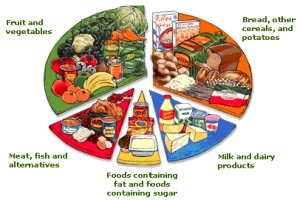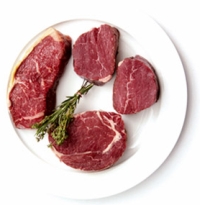Anti-Aging Diet – How To Eat Healthy Diet

What we eat, and when, has a direct effect upon our body systems. By eating a balanced diet we can stay healthy, maintain energy levels, preserve healthy muscles and bones and help our brains to work efficiently, no matter how old we are. The guidelines for a balanced diet are straightforward and are based on eating the right amounts of foods from various different food groups.
Food Groups: There is a broad consensus among doctors and nutritionists that foods fall into several discrete categories and that we should eat specific percentages of different types of foods. The breakdown of these food groups are as follows:
- Fruits and vegetables – 34 percent
- Bread, cereals and potatoes – 29 percent
- Low-fat milk and dairy products – 15 percent
- Meat, fish, eggs, nuts – 14 percent
- Fats, oils and sugary foods – 8 percent

When To Eat:
Traditionally, people have eaten three meals a day: breakfast in the morning, lunch at midday and dinner in the evening. Although this is a useful template, people often develop the habit of eating a small breakfast and lunch and a large evening meal. This has a detrimental effect on digestion, especially as our digestive systems become more sluggish with age. It also means that we have an inadequate supply of energy at the times of day when we are most active and a calorie overload at the end of the day when we are winding down. A preferable eating pattern is a large breakfast, a substantial lunch and a comparatively small meal early in the evening. Alternatively, some people favour the grazing approach to eating in which they eat small quantities of food throughout the day. This prevents overloading the digestive system and ensures a consistent supply of energy throughout the day. The grazing method is also a good way of stabilizing blood sugar levels in the body, which may be useful for people suffering from adult-onset diabetes.

How Healthy Is Meat:
Meat has had a lot of bad press in many countries in recent years for reasons such as infection with bovine spongiform encephalopathy(BSE) or the presence of antibiotics. Meat is high in saturated fat, which is implicated in the development of heart disease. It is also high in an amino acid called arachidonic acid, which increases levels of pro-inflammatory chemicals and should therefore be avoided by people of a rheumatic disposition. It does, however, still remain possible to eat meat safely. If you are concerned about the presence of antibiotics, choose organically produced meat, and cut away any visible fat on meat to avoid consuming too much saturated fat. Moderation is the key: the World Cancer Research Fund recommends that no more than 75g / 3oz of meat should be eaten per day.

Eaten in moderation, meat is a useful source of antioxidant minerals such as zinc and selenium. Antioxidants can help prevent degenerative diseases, such as cancer. Beef is a good source of iron, zinc and B vitamins; choose lean cuts such as topside in which the fat content is only 2.7 percent per 115g / 4oz – minced beef can contain upto 25 percent fat. Pork supplies B vitamins, iron, zinc and selenium. Excess fat should be removed and pork cracking should be avoided. Chicken supplies only about half the zinc and iron of red meats, but if the skin is removed prior to cooking it is very low in fat. It is also an excellent source of the antioxidant selenium. Older people are advised to eat plenty of oily fish because they contain omega-3 fatty acids. These are essential fatty acids that are vital for health but cannot be made by the body. Omega-3 fatty acids can help fight against heart disease and are found in abundance in salmon, mackerel, sardines, pilchards, herrings, kippers and tuna.